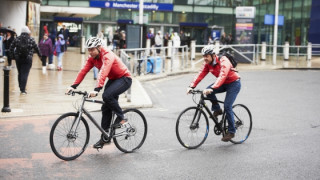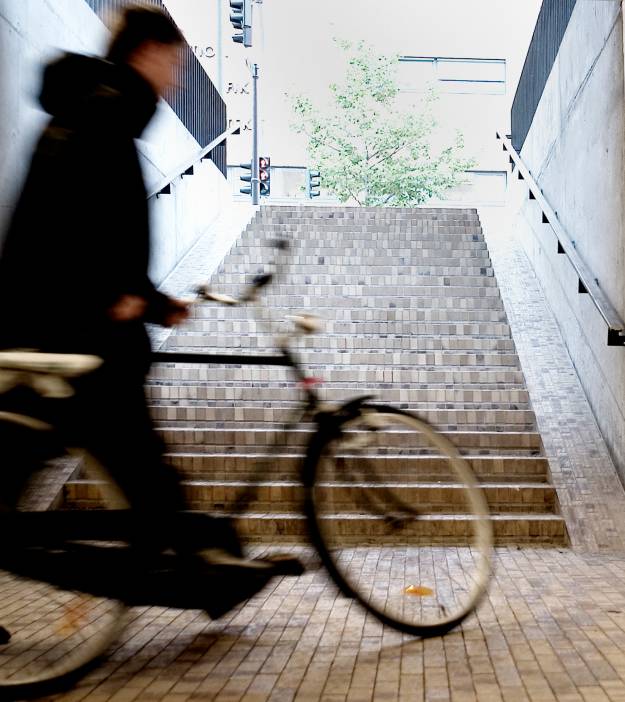A few weeks ago, dressed in everyday clothes, Sir Chris Hoy and Chris Boardman made the point that you shouldn’t need to be an Olympian to cycle to work. Here, British Cycling's infrastructure expert explains how with relatively small amount of investment this route could be made fit for the home of Cycling.
The Journey: Manchester Piccadilly Station to the National Cycling Centre
 |
| Above: The Journey: 2.6 miles, 15 mins @ 10mph |
In September 2013 Chis Boardman and Chris Hoy joined Adrian Lord, British Cycling’s Infrastructure Expert to cycle from Manchester Piccadilly Station to the home of British Cycling.
Many of British Cycling’s elite athletes and staff make this journey everyday but like many roads in Britain it has not been cycle-proofed, meaning that people on bikes and motor vehicles often get in each other’s way or travel too close to each other for comfort.This is uncomfortable for experienced cyclists and it puts people off from travelling by bike despite the short distance and flat terrain.
The route between Piccadilly Station and British Cycling headquarters encompasses many aspects of a typical short journey in any major city. Starting from the station on the edge of the city centre, it uses relatively quiet streets that run parallel to two major road corridors (Oldham road and Ashton Road). It crosses two major orbital roads, passing through inner city residential areas and edge of town retail parks to reach the major attractions of the National Cycling Centre and the wider Sports City.
Quiet radial routes such as this one have the potential to be great cycling corridors. They do not (or at least should not) carry through traffic and there is no need for high speed limits as their primary function is for access to residential property and car parks in the city centre.
Store Street
|
|
| Above: This treatment is common in the Netherlands. It defines clear wide lane for cyclists and places the onus on drivers to negotiate with other oncoming traffic, therefore helping to reduce speeds. |
Heading east from the station this is the most obvious route to take to the velodrome. It is a relatively quiet access street leading to car parks used by long-stay commuters and rail travelers. It has a 30mph speed limit and two lanes of traffic.
The road is about 7.5m wide but with restricted parking and low levels of pedestrian use there is the option of implementing cycle lanes. However, because the road is straight and quiet it encourages motor traffic to travel at higher speeds.
The relatively wide footways on the approach to the railway bridge offer scope to inset the parking bays, helping to free-up road space for cyclists and cars. These can be designed at footway level so they can be used by pedestrians when no cars are parked.
Recommendations:
- Reducing the speed limit to 20mph would offer the scope to remove the centre line and introduce cycle lanes as in the photo below.
- Arranging parking into alternate bays to create a chicane effect, and using parts of wide footways where there are few pedestrians to create bays can help reduce speeds and free-up carriageway space to reduce conflict between cyclists and cars on narrower roads and enable more continuous cycle lanes.
Junction of Great Ancoats St A665 / Store St Junction
|
|
| Above: Cycle lane with separate signal for cyclists (Photo: Department for Transport). |
There is no special provision for cycling on the outbound junction from Store Street, there is an advanced stop line on the inbound lane from Old Mill St. There is no provision for cyclists along the A665. There are no direction signs to indicate the way to Sportscity for cyclists.
At a big junction like this where lots of traffic uses the inner ring road and is turning into the adjacent retail park, but the cycle route itself is relatively quiet it would be helpful to have a separate facility for cyclists.
For people on bikes travelling north-south on Great Ancoats Street a separate cycle track alongside the carriageway would allow left-turning to proceed without waiting for the lights.
Recommendations:
- A separate signal phase on the traffic lights, possibly shared with the pedestrian crossing phase would eliminate any risk from turning traffic, or possibly something such as the arrangement below.
- The lights can be triggered by a detector loop embedded in the tarmac on the approach so that they change automatically as the cyclist approaches at quieter times, and backed up by a push button to call the signal at busier times.
Old Mill Street
|
|
| Above: Old Mill Street - a missed opportunity |
This starts as awide street which narrows when it approaches a residential area. It has a a 20mph limit through out. The street has had the ‘urban design’ treatment but cyclists have been ignored.
The narrow carriageway covers a long straight section where drivers might try to overtake. There is plenty of room to make a cycle facility, or for the whole street to be redesigned to enable safe overtaking of cyclists.
The unusual (in Britain) use of textured surface materials such as block paving indicates helps indicate that this is low-speed road.
In many European coutries coloured stone is used to indicate shared road space. This approach could be more widely applied throughout the UK but consistent standards are required to make it easy for road users to understand.
Recommendation:
- This is an example of a newly built road with little consideration given to cycling. The road space is wide enough to provide cycling lanes.
Bradford Road
|
|
| Above: In this Netherlands cycle street cars are guests. The raised central margin encourages slow, careful overtaking. |
This straight 30mph limit road is through a residential area with green space. The road should be made safe for child pedestrians and cycling but the present design allows cars to travel is still dominated by car parking and completely straight carriageways that enable higher speeds.
The road has been ‘narrowed’ to make drivers slow down but this creates problems for people on bikes by encouraging close overtaking maneuvers.
Recommendation:
- This road should have a 20mph limit with chicanes installed to provide parking and help limit speed. A segregated cycle track could be provided next to the northbound lane.
Alan Turing Way
Alan Turing Way is a dual carriage way with 30 mph speed limit but with high traffic volume. Cycle tracks are provided but there is no sign and it would be possible to miss them when turning from the junction.
Bus stops can be perceived to be a problem with this sort of kerb-segregated facility but this one has operated successfully for several years. It offers cyclists good protection from high speed traffic along a busy road, but the track is intermittent and covers only a short distance between the Oldham Road and Ashton Road.
Where on-road cycle lanes are provided they do not meet the recommended 1.5m minimum width to give cyclists adequate protection from adjacent traffic.
Recommendation:
- This could be improved with some significant work to move the kerb lines and deal with drainage issues. It’s likely that the present arrangement was a compromise to minimize costs.
Is this journey safe, convenient and attractive?
Each time a cyclist has to stop and start the additional physical effort required is equivalent to adding 200m to the journey. Over 75% of UK journeys (by all modes) are under 2 miles so just a few stops can add significantly to the overall effort required. An Olympian might regard this as interval training, but for the rest of us it’s just tiresome and inconvenient and can even result in collisions as people continually leave and rejoin the road.
Dutch design guidance places great emphasis on reducing the need for cyclists to slow down and stop by giving them priority as much as possible, and making short journeys by bike more convenient than driving by placing the onus on drivers to slow down and stop at places where minor roads intersect with cycle routes, and giving adequate and convenient traffic signal time to cyclists at major roads.
Cycle-proofing is about ensuring that these measures are widely used and every opportunity is taken to design them in to roads and junctions. Many of these features are perfectly legal under UK law but they are poorly understood and implemented. Some features are, such as 'Dutch style' roundabouts, low-level traffic signals and left-turning a red lights are illegal but solutions required to improve safety and sharing space.
Recommendations:
- It is essential that when introducing separate tracks to take cyclists away from other traffic, designers pay attention to priority at junctions and crossings to minimize stopping, otherwise many cyclists will not use the cycle tracks.
- This will require unpopular political decisions about accepting additional delays to motor traffic at some locations and its important to present plans in the context of a long term vision for a more sustainable, safe and healthy society where streets are less dominated by cars.

















